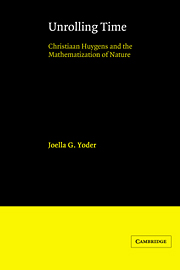Summary
What, finally, can be said about the man and his method and about their significance? The pattern by which he worked is clearly evident. He was usually spurred to action by a problem posed by another, particularly if solving that problem carried prestige. Once undertaken, it was usually pursued systematically and relatively rapidly to its solution, at which point the salient results were summarized in a short treatise. Because of his thoroughness, Huygens's results often held much broader significance than the original problems from which they stemmed, but they were seldom linked together into a unified theory or applied to new areas, unless resparked by other researchers.
Examples of motivation from the outside abound in Huygens's work. Although his stature with Mersenne had been determined in part by his proof that the catenary was not a parabola, he never returned to the hanging chain to find its true shape until challenged by Jakob Bernoulli. Likewise, he never pursued an inconsistency that he had noted in Bernoulli's analysis of inflection points until he was questioned by 1'Hospital. In still another case, having come to a different conclusion than Bernoulli regarding the sail curve, he asked l'Hospital if he believed Bernoulli's results, concluding, “Your authority would set me to repeat the examination.” Otherwise, it must be presumed, he would not bother to redo his calculations, since there was no guarantee that the effort would “pay.”
Obviously, someone who depended so heavily upon outside stimuli could hardly adhere to a conscious research program.
- Type
- Chapter
- Information
- Unrolling TimeChristiaan Huygens and the Mathematization of Nature, pp. 169 - 179Publisher: Cambridge University PressPrint publication year: 1989



